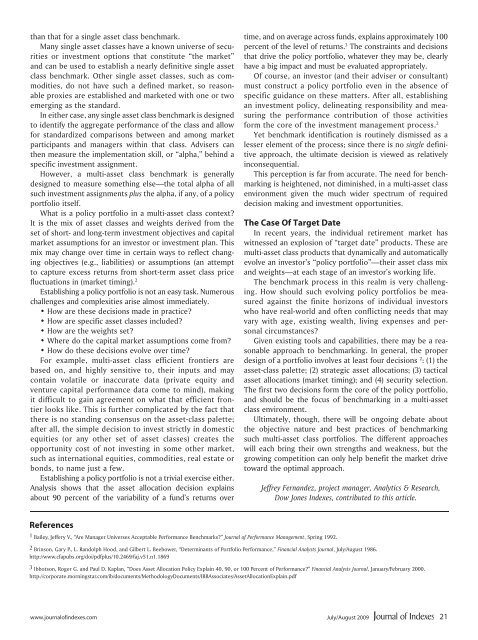How to Kill a Black Swan Remy Briand and David Owyong ...
How to Kill a Black Swan Remy Briand and David Owyong ...
How to Kill a Black Swan Remy Briand and David Owyong ...
Create successful ePaper yourself
Turn your PDF publications into a flip-book with our unique Google optimized e-Paper software.
than that for a single asset class benchmark.<br />
Many single asset classes have a known universe of securities<br />
or investment options that constitute “the market”<br />
<strong>and</strong> can be used <strong>to</strong> establish a nearly definitive single asset<br />
class benchmark. Other single asset classes, such as commodities,<br />
do not have such a defined market, so reasonable<br />
proxies are established <strong>and</strong> marketed with one or two<br />
emerging as the st<strong>and</strong>ard.<br />
In either case, any single asset class benchmark is designed<br />
<strong>to</strong> identify the aggregate performance of the class <strong>and</strong> allow<br />
for st<strong>and</strong>ardized comparisons between <strong>and</strong> among market<br />
participants <strong>and</strong> managers within that class. Advisers can<br />
then measure the implementation skill, or “alpha,” behind a<br />
specific investment assignment.<br />
<strong>How</strong>ever, a multi-asset class benchmark is generally<br />
designed <strong>to</strong> measure something else—the <strong>to</strong>tal alpha of all<br />
such investment assignments plus the alpha, if any, of a policy<br />
portfolio itself.<br />
What is a policy portfolio in a multi-asset class context?<br />
It is the mix of asset classes <strong>and</strong> weights derived from the<br />
set of short- <strong>and</strong> long-term investment objectives <strong>and</strong> capital<br />
market assumptions for an inves<strong>to</strong>r or investment plan. This<br />
mix may change over time in certain ways <strong>to</strong> reflect changing<br />
objectives (e.g., liabilities) or assumptions (an attempt<br />
<strong>to</strong> capture excess returns from short-term asset class price<br />
fluctuations in (market timing). 2<br />
Establishing a policy portfolio is not an easy task. Numerous<br />
challenges <strong>and</strong> complexities arise almost immediately.<br />
• <strong>How</strong> are these decisions made in practice?<br />
• <strong>How</strong> are specific asset classes included?<br />
• <strong>How</strong> are the weights set?<br />
• Where do the capital market assumptions come from?<br />
• <strong>How</strong> do these decisions evolve over time?<br />
For example, multi-asset class efficient frontiers are<br />
based on, <strong>and</strong> highly sensitive <strong>to</strong>, their inputs <strong>and</strong> may<br />
contain volatile or inaccurate data (private equity <strong>and</strong><br />
venture capital performance data come <strong>to</strong> mind), making<br />
it difficult <strong>to</strong> gain agreement on what that efficient frontier<br />
looks like. This is further complicated by the fact that<br />
there is no st<strong>and</strong>ing consensus on the asset-class palette;<br />
after all, the simple decision <strong>to</strong> invest strictly in domestic<br />
equities (or any other set of asset classes) creates the<br />
opportunity cost of not investing in some other market,<br />
such as international equities, commodities, real estate or<br />
bonds, <strong>to</strong> name just a few.<br />
Establishing a policy portfolio is not a trivial exercise either.<br />
Analysis shows that the asset allocation decision explains<br />
about 90 percent of the variability of a fund’s returns over<br />
time, <strong>and</strong> on average across funds, explains approximately 100<br />
percent of the level of returns. 3 The constraints <strong>and</strong> decisions<br />
that drive the policy portfolio, whatever they may be, clearly<br />
have a big impact <strong>and</strong> must be evaluated appropriately.<br />
Of course, an inves<strong>to</strong>r (<strong>and</strong> their adviser or consultant)<br />
must construct a policy portfolio even in the absence of<br />
specific guidance on these matters. After all, establishing<br />
an investment policy, delineating responsibility <strong>and</strong> measuring<br />
the performance contribution of those activities<br />
form the core of the investment management process. 2<br />
Yet benchmark identification is routinely dismissed as a<br />
lesser element of the process; since there is no single definitive<br />
approach, the ultimate decision is viewed as relatively<br />
inconsequential.<br />
This perception is far from accurate. The need for benchmarking<br />
is heightened, not diminished, in a multi-asset class<br />
environment given the much wider spectrum of required<br />
decision making <strong>and</strong> investment opportunities.<br />
The Case Of Target Date<br />
In recent years, the individual retirement market has<br />
witnessed an explosion of “target date” products. These are<br />
multi-asset class products that dynamically <strong>and</strong> au<strong>to</strong>matically<br />
evolve an inves<strong>to</strong>r’s “policy portfolio”—their asset class mix<br />
<strong>and</strong> weights—at each stage of an inves<strong>to</strong>r’s working life.<br />
The benchmark process in this realm is very challenging.<br />
<strong>How</strong> should such evolving policy portfolios be measured<br />
against the finite horizons of individual inves<strong>to</strong>rs<br />
who have real-world <strong>and</strong> often conflicting needs that may<br />
vary with age, existing wealth, living expenses <strong>and</strong> personal<br />
circumstances?<br />
Given existing <strong>to</strong>ols <strong>and</strong> capabilities, there may be a reasonable<br />
approach <strong>to</strong> benchmarking. In general, the proper<br />
design of a portfolio involves at least four decisions 2 : (1) the<br />
asset-class palette; (2) strategic asset allocations; (3) tactical<br />
asset allocations (market timing); <strong>and</strong> (4) security selection.<br />
The first two decisions form the core of the policy portfolio,<br />
<strong>and</strong> should be the focus of benchmarking in a multi-asset<br />
class environment.<br />
Ultimately, though, there will be ongoing debate about<br />
the objective nature <strong>and</strong> best practices of benchmarking<br />
such multi-asset class portfolios. The different approaches<br />
will each bring their own strengths <strong>and</strong> weakness, but the<br />
growing competition can only help benefit the market drive<br />
<strong>to</strong>ward the optimal approach.<br />
Jeffrey Fern<strong>and</strong>ez, project manager, Analytics & Research,<br />
Dow Jones Indexes, contributed <strong>to</strong> this article.<br />
References<br />
1 Bailey, Jeffery V., “Are Manager Universes Acceptable Performance Benchmarks?” Journal of Performance Management, Spring 1992.<br />
2 Brinson, Gary P., L. R<strong>and</strong>olph Hood, <strong>and</strong> Gilbert L. Beebower, “Determinants of Portfolio Performance,” Financial Analysts Journal, July/August 1986.<br />
http://www.cfapubs.org/doi/pdfplus/10.2469/faj.v51.n1.1869<br />
3 Ibbotson, Roger G. <strong>and</strong> Paul D. Kaplan, “Does Asset Allocation Policy Explain 40, 90, or 100 Percent of Performance?” Financial Analysts Journal, January/February 2000.<br />
http://corporate.morningstar.com/ib/documents/MethodologyDocuments/IBBAssociates/AssetAllocationExplain.pdf<br />
www.journalofindexes.com July/August 2009<br />
21
















